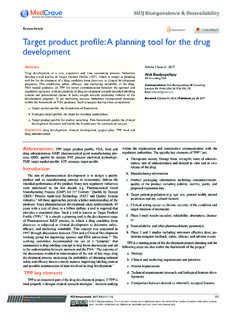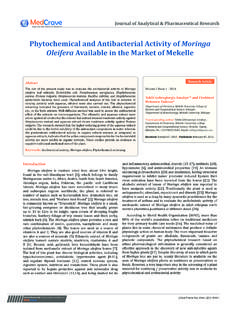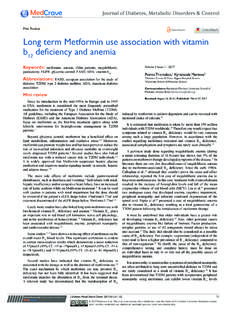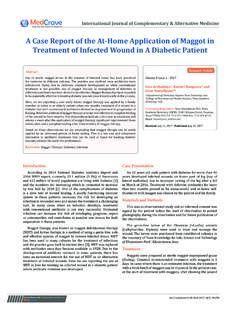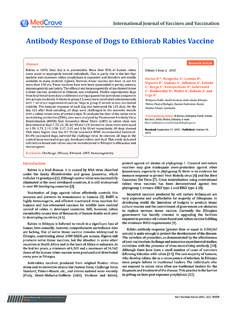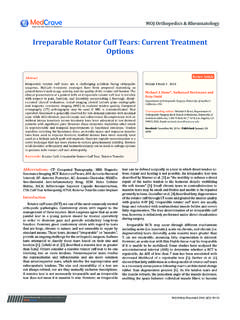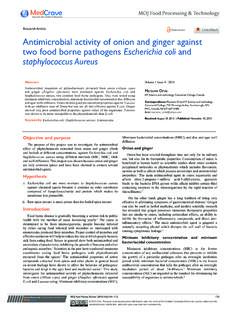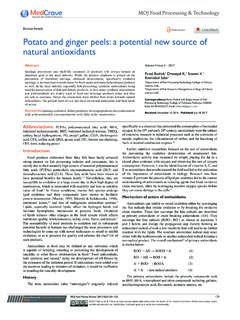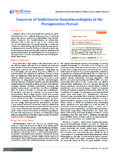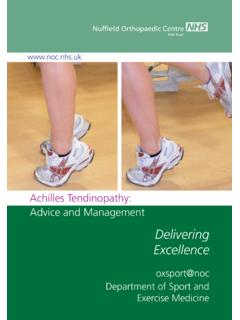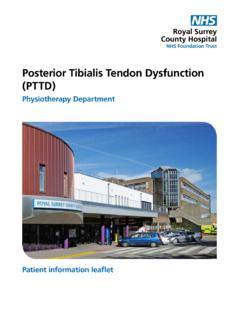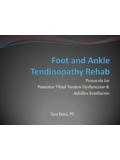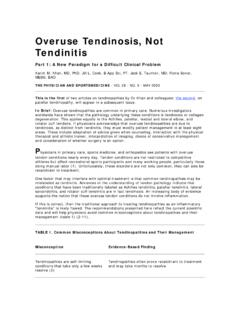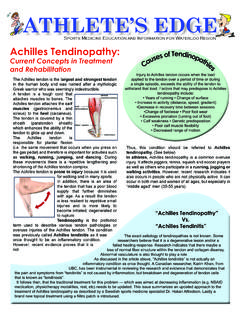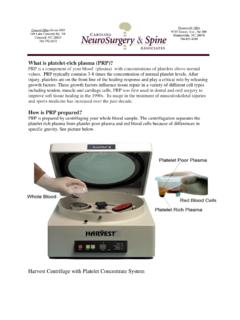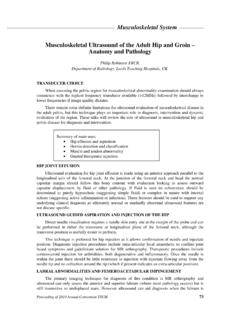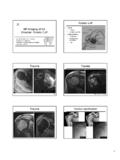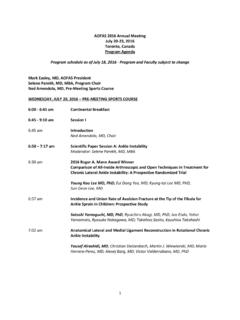Transcription of Occupational Risk Factors for Shoulder Tendon …
1 MOJ Orthopedics & Rheumatology Occupational Risk Factors for Shoulder Tendon disorders 2015 update Abstract Case Report Evidence for work-related exposure as a cause of Shoulder tendinopathy is Volume 3 Issue 4 - 2015 . updated. Previous studies indicated that forceful movements combined with hands above head increases the likelihood of Shoulder disorders . Hands above the Shoulder and arm flexion or abduction at greater than 60 combined with Orland Park Orthopedics, USA. forceful or repetitious motions results in significantly increased occurrence of Shoulder tendinopathy. Shoulder disease is multifactorial with genetics, age, Corresponding author: Blair A Rhode, Orland Park and bodyweight correlated with increased occurrence though they are minor Orthopedics, 16450 S 104th AV, Orland Park, IL 60467, USA, Factors for young workers.
2 Normal aging of the rotator cuff may underlie much of Tel : 708-364-8441; Fax: 708-364-8443; Email: Shoulder disease for individuals older than 60 thereby presenting a complication for the determination of work-related rotator cuff tears in this group. In contrast, Received: October 21, 2014 | Published: November 3, 2015 . there is sufficient evidence to support work-related musculoskeletal disorders of the Shoulder in younger individuals who have not undergone the aging processes. Numerous reviews along with individual cross sectional and longitudinal studies conclude that Shoulder tendinopathy can result from work-related exposures based on the odds and relative risks of occurrence in a working population compared to a group that has not been similarly exposed to comparable manual effort.
3 Keywords: Rotator cuff; Tendinopathy; Musculoskeletal; Worker's comp;. Forceful; Repetition;. Abbreviations: RCT: Rotator Cuff Tear; MRI: Magnetic Reso- es depend on age, sex, and location. nance Imaging; MSD: Musculoskeletal Disease; AMA: American Overhead work with arm (humeral) abduction is associated Medical Society; BLS: Bureau of Labour Statics; NIOSH: National with the development of pain and injury [3-6]. Overhead work Institute of Occupational Safety And Health; OR: Odds Ratio; BMI: has a several-fold increased risk for Shoulder disorders [7-10]. Body Mass Index; EMG: Electromyography; RCS: Rotator Cuff Syn- Injury severity is linked to cycle time of the overhead workload drome; IME: Independent Medical Evaluation; SIS: Shoulder Im- [11] along with more tissue damage due to increased exposure to pingement Syndrome overhead postures [12].
4 Lifting weights >10 kg above the shoul- Background der even for short periods resulted in significant risk for Shoulder pain [13]. Work-related upper extremity musculoskeletal disorders (WRUEMSDs) which include carpal tunnel syndrome, tendinitis Recently AMA undertook an exercise to update the MSD sci- and arthritis are associated with high costs to employers due to ence, expand the focus and overall improve the understanding absenteeism, lost productivity, increased health care costs, along of causation of Disease which resulted in the 2nd Ed of the AMA. with disability and workers' compensation costs.
5 Bureau of Labor Guides to the Evaluation of Disease and Injury Causation [14]. Statistics (BLS) in 2012 reported nonfatal Occupational injuries The findings relating rotator cuff disease or Shoulder impinge- totaled 1,153,980 cases with a median 9 days away from work ment syndrome (SIS) causation are similar to those of the earlier which is equivalent to 41,543 years of work [1]. NIOSH review [15]: First, strong evidence for sustained awkward postures with >60 of arm flexion or abduction. Second, some Tendinitis or Shoulder injuries constitute a significant portion evidence for highly repetitive work alone or in combination with of workplace injuries and are often linked to overhead work [2].
6 Other Factors such as very high job structural constraints or force- Significant time is lost along with significant expenses associated ful exertions or forceful pinch. Third, insufficient evidence for an with this disability. BLS stated that Shoulder injuries accounted effect resulting from forceful work based on the earlier NIOSH. for of musculoskeletal disorders (MSDs) claims irrespec- (1997) review. In contrast, a study of physical work Factors con- tive of occupation. Rotator cuff tendons are dependent on their ducted in random sample of workers in France found that manual structure and cellular organization for function and response to male workers had more than twice the rate of rotator cuff syn- physiologic loading.
7 Tendons have a non-linear, viscoelastic re- drome (RCS) than non-manual workers. The conclusion was that sponse to applied cyclic tensile loads. Overstimulation of Tendon manual workers are at high risk for upper limb disorders [16]. through either single or repetitive loading results in collagen fibril damage. Repetitive loading may lead to mechano-biological over- Rotator cuff (RC) injuries have been classified as intrinsic stimulation and hence degenerative processes that determine cell when that Tendon injury results from direct Tendon overload, in- fate. The precise loads necessary to induce degenerative process- trinsic degeneration, or other insult.
8 RC injury mechanisms are Submit Manuscript | MOJ Orthop Rheumatol 2015 , 3(4): 00104. Copyright: Occupational Risk Factors for Shoulder Tendon disorders 2015 update 2015 Rhode et al. 2/8. extrinsic when: 1) the Tendon is damaged through compression arm flexion or abduction > 60 while performing forceful tasks. against surrounding structures usually the coracoacromial arch Tendons exhibit plastic deformation which can occur with repeat- [17]; 2) Elevation of the arm may either tear or squeeze subacro- ed motions. A variety of research paths are being addressed to mial Tendon structures [18]; and 3) Microcirculation in the Tendon better understand the Tendon complex in use [32].
9 Is impaired by high intramuscular pressure resulting in inflam- Because there are multiple risk Factors associated with shoul- mation (tendinitis) leading to degeneration [19]. It is not always der disorders including trauma, overuse, inflammation, age-relat- clear which of these three injury mechanisms explains a patient's ed tissue degeneration, and smoking, a careful history is required RC injury and overuse likely affects both intrinsic and extrinsic to sort out injury and causation [33]. Age is a significant factor Factors . in developing tendinopathy and it becomes a dominant factor for The overuse theme is common for workers in industrial occu- patients > 60 years old [27].
10 Occupational history detailing work pations that perform repetitive manual tasks resulting in an in- exposure is essential. Patients complain that they cannot perform creased prevalence of Shoulder disorders [20,21]. For example, regular job duties, such as lifting overhead, pushing heavy objects, prevalence rate of Shoulder pain among cashier workers exposed or performing tasks that require arm motion. to repetitive work was compared to 16% in an unexposed Because MSDs are a major cause of mobidity throughout the group [22]. Both repetition and force requirements contribute to world there is increasing attention devoted to its multifactorial increased risk of Shoulder tendonitis with a rate in a Danish nature.
